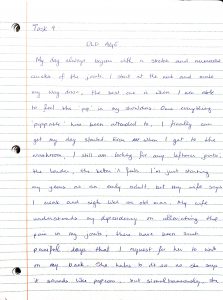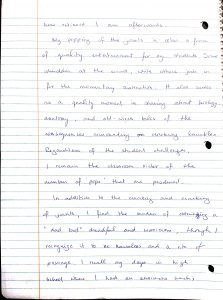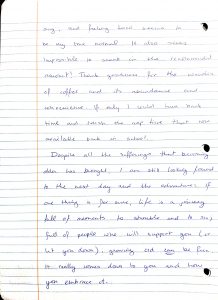



Written Commentary
It is evident that my writing ability has declined as of late, as my endurance to commit pen to paper has shortened considerably (as my penmanship started out well but devolved into chicken scrabble near the finale). I mainly use my computer as means of writing and composing of text, though do write things with pen when completing marking on student assessments.
This task was more difficult than I had planned; just as the monks struggled with their procurement of writing materials (Harris, 2018), I had to scavenge around my environment for lined paper (not grid or computer), a working pen, and a clean and flat surface to write upon. Although my computer paper was within easy reach, I deliberately searched for lined paper, as I knew that my alignment of sentences would likely curl and hardly qualify as straight (and if I had to repeat each page as the monks had to do as well, I would have likely quit the whole monastery itself). The flat surface was somewhat a difficult task; my laptop computer is a convenience to bring anywhere and everywhere, so I tend to work comfortably in a variety of spaces as opposed to a dedicated flat surface.
As I wrote this in pen, I could not erase my work as I would easily do with virtual text. I opted to scribble out the incorrect word or write over it, and I recognize that it did not look quite professional or as ‘clean’ as I intended it to be. One consideration that I re-discovered with writing on paper was how I had to think about how much space I would have for the whole word on the remainder of the line; if I did not have enough space, I would need to start the next line below or choose to squeeze in the word by changing the spacing between letters. With virtual writing, I have no consideration at all; the words wrap down to the next line as soon as the technology deems that the space is insufficient.
There are several significant differences between writing mechanically on paper and writing virtually on a screen. The first and perhaps the most critical, is the speed at which words can connect onto the paper as I form a sentence in my head. The physical limitations of my hand severely hamper the mechanization of writing; I think much faster than I can write and thus lose formed thoughts and direction of my writing. In contrast, the virtual mechanization of writing on a screen is more fluid and free; my typing speed can closely match the sentence formation in my head and thus my virtual text seems more connected together. The second difference is the opportunity to edit my work. For the monks writing on their animal hide, they had but a few seconds to remove the ink before it set forever (Harris, 2018). And when the page was brought for peer review for a higher order monk, any displeasure in how it looked would result in the entire page thrown away to be redone (Harris, 2018). With mechanized writing on paper today, I (thankfully) did not need to throw my paper away and redo its entirety; rather, I just crossed out the word or wrote over it (due to laziness) and kept on writing. With mechanized writing on my computer, a life-saving button – backspace – is sufficient in removing all presence of a word I wrote in the past; therefore, the significant difference is the erasure of proof of writing. With the paper copy, my written work (mistakes and all) are scribed onto its page and all my work can be seen. In contrast, my written work on the virtual copy looks clean and perfect (I do hope so) as if I wrote it on my first attempt. Finally, the last significant difference is a secondary perspective in checking my work. With the paper version of my work, there is only one perspective; my own. If I misspelled a word or used grammatically incorrect phrasing, I would be none the wiser. For my virtual work, a computer program informs me gently through the use of coloured underlines that something is amiss; hence, the second perspective. Even as I spelled colour with a ‘u’, it is nudging me to attend to its correct adherence of spelling it as ‘color’. I am, however, not a monk and refuse to bend to the higher power of the red underlines and will choose to keep my spelling as I originally intended. In closing, the three major differences are writing speed, editing power, and a second perspective.
References:
Harris, Brad. (Host). (2018, February 5). THE PRINTED BOOK: OPENING THE FLOODGATES OF KNOWLEDGE. [Audio podcast episode] In How It Began. https://howitbegan.com/episodes/the-printed-book/